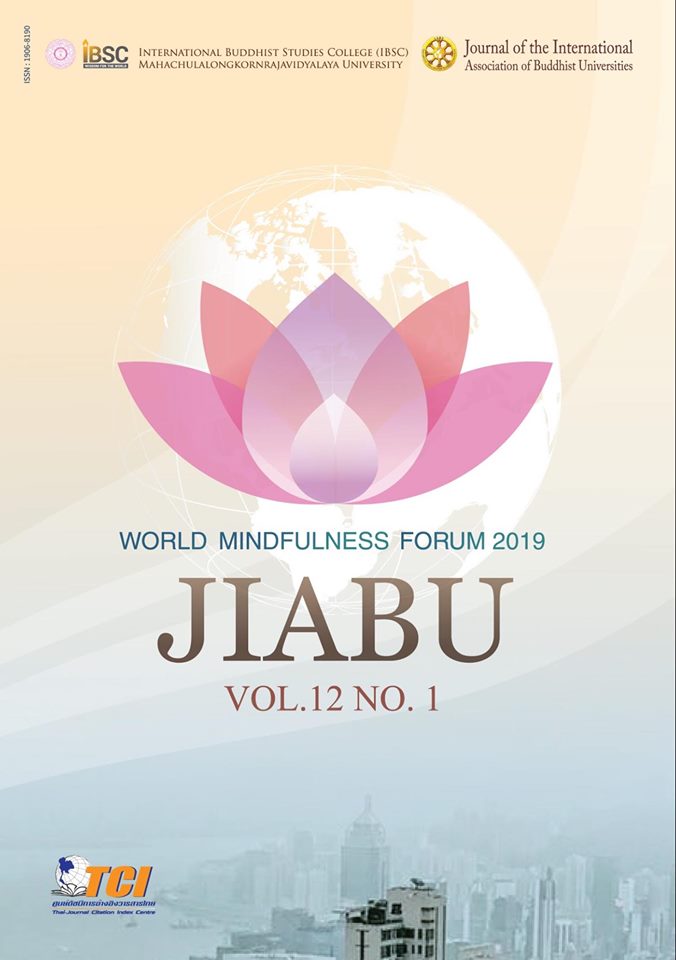The Evolution of Early Chinese Buddha Figures
Main Article Content
Abstract
The Buddha, Dhamma and Sangha compose the Triple Gem in all Buddhist traditions
(Theravada, Mahayana and Vajrayana), and the Buddha figure, image or statue usually
represent the Lord Buddha after his Mahaparinirvana. However, Buddha figures evolved
in different cultures and developed in various styles influenced by the Buddhism that was
introduced into and practiced in those different cultures.
The aim of this article is to study the evolution of early Chinese Buddha figures that
were produced over the period of the Eastern Han Dynasty (25 B.C. – 220 A.D.) and though
to end of the Tang Dynasty (618 A.D. – 907 A.D.). This period was important because it
was during this time that Buddhism developed and transformed from being a cultural import
into something more uniquely Chinese in style. This adaptation into a real Chinese form
of Buddhism can be seen in the areas of sutra translation, Buddhist teachings and Buddha
figures. This article is mainly focused on the characteristics of Chinese Buddha figures, such
as roble style, facial features, and hairstyles during this early time of evolution. The article
also examines the factors that influenced the evolution of early Chinese Buddha figures;
these factors caused the Buddha figures to gradually change in appearance.
Article Details
Views and opinions expressed in the articles published by The Journal of the International Association of Buddhist Universities (JIABU), are of responsibility by such authors but not the editors and do not necessarily reflect those of the editors.
References
Chinese Buddhist Electronic Text Association.vol.23.
Zhi Pan, History Chronicles for Buddha,Vol. 35, 2035. 49. P0129, Taisho Tripitaka
(Chinese,宋咸淳四明东湖沙门志磐撰,《佛祖统纪卷》第三十五, 2035. 49. P0129,
大正藏).
Hui Jiao, Biography of Eminent Monks, Vol.13, 2059.50. P0322, Taisho Tripitaka (Chinese :
释慧皎,《梁高僧传》卷第十三, 2059. 50. P0322,大正藏).
History of Later Han Vol.42, Biography of Ten State Kings of Emperor Guang Vol.32
(《后汉书》卷四十二,光武十王列传第三十二).
Gray Williams, Jr. Anne Preuss & Katharine H.B. Stoddert, (1965). The Metropolitan Museum
of Art Volume XXIII, Number 9. The Metropolitan Museum.
Chen Yuexin, A Study to the Regulation of Dressing for Chinese Buddhist Statues from
the 5th to the 8th Century (《5-8世纪汉地佛像着衣法式》 ). 2014, Social sciences
academic press (China).
Fang Litian & Hua Fangtian, Brief History of Chinese Buddhism, Religion Publisher (中
国佛教简史), May 2001.
Yang Huinan, The Faith of Maitreya in Chinese Buddhist Texts Translation
(《汉译佛经中的弥勒信仰:以弥勒上、下经为主的研究》 ), the Humanitas Taiwanica,
No. 35 (Dce.1987), College of Liberal Arts publication.
Liu Bin, The Completed Task of Shaanxi Archaeological Team for the Discovery History
Site in Shan Xia, Second Edition, 22 March, 2002, Journal of China Antique
(《陕西宝鸡考古队完成三峡文物发掘任务》,《中国文物报》2002年3月22日
第2版).
Wang Chenglin, Analysis of the Aesthetic Characteristics of Buddha’s Robe in Longmen Grottoes
from Tang Dynasty (《论龙门石窟佛像服饰的审美特征》 ). Journal of Beauty &
Generation (美与时代), No. 10,2014.
Fei Yong, The Issue for the Samakaksika and Half Shirt of the Buddha’s Dressing (佛像服
饰中的“僧祇支”与“偏衫”问题) No.01,2008. The Journal of Dunhuang Studies.

